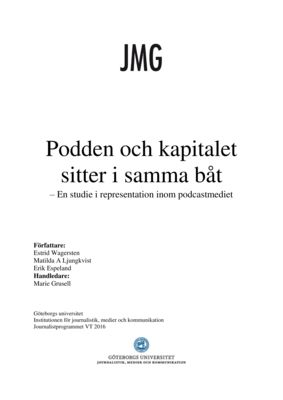Podden och kapitalet sitter i samma båt
En studie i representation inom podcastmediet
This study examines the diversity amongst podcasters in Sweden using Bourdieu’s theories on field and capital. To examine who gets heard in the medium, we have used the iTunes top chart for podcasts. Totally we have studied 136 podcasts. We chose the theme for this study partly because we, the authors, listen to a lot of podcasts and one of us even produces one. Podcasts are seen as an open media, where anyone with an internet connection and a good idea can produce and distribute their own show. Because of this notion, while listening to podcast, we reacted to what seemed to be an overrepresentation of white men. We wanted to see if this really was the case, and if so, why?
Our results show that the composition of people on the iTunes top chart is very homogeneous. There is an overrepresentation of men in the age of 20-35 and an underrepresentation of non-whites and homosexuals. Our study also shows a geographical concentration around the capital of Sweden, Stockholm, where almost 80 percent of podcasts on the top chart is produced. There is also a majority of people in the podcast field that are famous or have prior experience in media production.
We trace this skewed representation by applying Bourdieu’s theories and regarding the Swedish podcast medium as a field acting homological to the media-field and the field of power. This means that already existing social structures in the media-field are likely to reproduce in the podcast field, making already dominant social agents in the former more likely to dominate the latter. Our study shows that even though the podcast is characterized by a more informal, conversational style and an aura of openness, it reflects little in a real shift of power regarding who gets heard in the public sphere.
Keywords: podcast, pod, representation, diversity, Bourdieu, field theory

